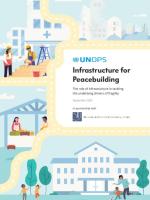The infrastructures of peace
Infrastructure is most notable for its absence in most fragile and conflict-affected states. Many peacekeeping and statebuilding efforts therefore expend huge efforts and budgets on infrastructure, hoping to contribute to peace, stability, and development. But can one engineer peace? Based on years of experience and research, a new UNOPS-DIIS report takes stock of the positive and negative impacts that infrastructure interventions have in fragile and conflict-affected states.
This report calls for infrastructure systems that focus on people’s needs, promote social cohesion and reduce inequalities, including gender inequality. So that we can all move towards a more peaceful, sustainable and resilient world
“This report calls for infrastructure systems that focus on people’s needs, promote social cohesion and reduce inequalities, including gender inequality. So that we can all move towards a more peaceful, sustainable and resilient world,” said UNOPS Executive Director Grete Faremo.
Introducing the report, Assistant Secretary-General for Peacebuilding Support, Oscar Fernandez-Taranco, added: “This paper is a fundamental contribution towards understanding how infrastructure plays a role not only in reconstruction and economic development processes, but also in addressing the root causes of violence and instability and preventing conflict.”
The report argues that infrastructure is a basic prerequisite for development and well-being. It has the potential to address some of the root causes of conflict. While addressing infrastructure needs in fragile and conflict-affected contexts can be particularly challenging, the report finds that the risk and cost of inaction are even higher.
Based on comprehensive research, the report points out that peacebuilding is an ongoing process that begins long before conflict takes place. When implemented with wider reforms, infrastructure investments can support long-term peace and resilience by enabling access to basic services and has the potential to foster structural changes that reduce the risk of violence and promote sustainable development.
On the other hand, infrastructure can hinder peacebuilding if services are lacking or if infrastructure is unable to protect communities. Poorly planned, designed and implemented infrastructure can fuel tensions by reinforcing an inequitable environment. Given the ‘lock-in’ effect caused by the long lifespan of infrastructure, investments that fail to account for the complex interactions that infrastructure has with fragility, risk contributing to prolonged instability.
Today, the stakes are higher than ever. Major gaps in access to infrastructure services became increasingly evident as the first confirmed cases of COVID-19 emerged in fragile and conflict-affected states. In countries experiencing conflict, health infrastructure can be increasingly subject to power disputes. The loss of health infrastructure in conflict settings can hinder peacebuilding attempts by hampering recovery efforts in the short-term and aggravating tensions over healthcare access in the long-term.
Further still, climate change-related shocks and stresses will worsen the pressure on poor and vulnerable groups living in fragile and conflict-affected states. Infrastructure has significant potential to protect communities from economic, environmental and societal crises that can lead to instability.
This report calls for increased knowledge and awareness of the role of infrastructure in fragile and conflict-affected states. It advocates a shift away from the traditional view of infrastructure as individual, isolated physical assets towards a holistic understanding of infrastructure as complex systems that interact with all dimensions of fragility.
DIIS Experts


